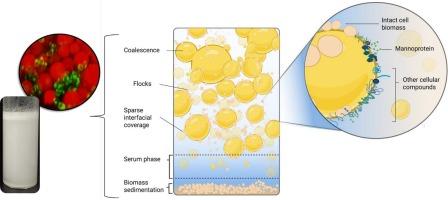利用酵母生物质稳定水包油乳状液
IF 9.8
1区 农林科学
Q1 CHEMISTRY, APPLIED
引用次数: 0
摘要
本研究旨在了解酵母生物量在稳定水包油乳剂中的作用。采用间歇发酵法培养3株食品级酵母菌(Saccharomyces cerevisiae, SC)、非常规酵母菌(NC1和NC2),获得生物量(粒径范围1-10 μm),用于稳定5-20 wt%的水包油乳剂。用生物质稳定的水包油乳状液表现出不同的稳定能力,SC在4周内阻止液滴聚结,平均液滴尺寸(D[4,3]) ~ 12 μm,而用NC1或NC2制成的乳状液在一周内迅速聚结。SC生物质的洗涤导致乳液不稳定,增加了正十四烷/水界面的界面张力,与细胞相关的松散结合蛋白的去除有关。总之,我们的研究结果指出了其他表面活性剂的潜在贡献,如SC生物质中表面/分泌的蛋白质稳定乳滴,而不是真正的皮克林稳定。本文章由计算机程序翻译,如有差异,请以英文原文为准。

Utilisation of yeast biomass to stabilise oil-in-water emulsions
This study aimed to understand the role of yeast biomass in stabilising oil-in-water emulsions. Three food-grade yeast strains (Saccharomyces cerevisiae (SC), non-conventional strains of yeast (NC1 and NC2)) were cultured using batch fermentation to obtain their biomass (size range 1–10 μm) and were used to stabilise 5–20 wt% oil-in-water emulsions. The oil-in-water emulsions, stabilised by biomass demonstrated varying stabilisation capacities, with SC preventing droplet coalescence for four weeks with mean droplet size (D [4,3]) ~ 12 μm whilst emulsions made using NC1 or NC2 showed rapid coalescence within a week. Washing of the SC biomass resulted in emulsion destabilisation and increase of interfacial tension of the n-tetradecane/water interface, associated with removal of loosely-bound proteins associated with the cells. In summary, our findings pinpoints the potential contribution from other surface-active agents such as surface/ secreted proteins in the SC biomass stabilising the emulsions droplets rather than a true Pickering stabilisation.
求助全文
通过发布文献求助,成功后即可免费获取论文全文。
去求助
来源期刊

Food Chemistry
工程技术-食品科技
CiteScore
16.30
自引率
10.20%
发文量
3130
审稿时长
122 days
期刊介绍:
Food Chemistry publishes original research papers dealing with the advancement of the chemistry and biochemistry of foods or the analytical methods/ approach used. All papers should focus on the novelty of the research carried out.
 求助内容:
求助内容: 应助结果提醒方式:
应助结果提醒方式:


